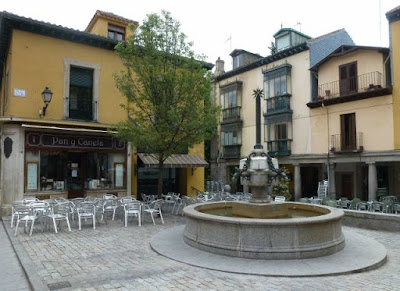This huge complex
was conceived by the reigning monarch King Phillip II as a thanksgiving gesture
for his victory over the French in 1557 at the battle of St Quentin. The battle
took place on St Lawrence’s day, so the building was designed in the shape of a
gridiron over which St Lawrence was reputedly martyred by roasting.
The construction
took place between 1563 and 1584 and was to fulfil several functions. The first
was to be a palace for the king and his royal household. Then it was to be a tomb
for his father Charles V, and also to be a monastery that would occupy the most floor space.
The approach from
the lower town shows a large but pleasing design.
From the side it
presents a much more austere picture, helped of course by a dull day.
Once inside, we see
why it was a royal palace. During the 16th century treasure from the
New World was pouring into Spain and it was spent on buildings such as this. The
library here contains immeasurably valuable 16th century books,
paintings and early scientific objects. Photos not allowed inside so I’ve used
some of the audio/visual guide pics.
The basilica has
the dimensions of a cathedral, with a 30 metre high magnificent altarpiece
containing numerous works of art.
Philip was
intensely religious and his simple bedroom had an internal window that allowed
him to look directly at this altar from his bed.
Another remarkable
room is the hall of battles, illustrated with scenes from Philip’s victories.
The whole of the left-hand wall features, unsurprisingly, the battle of St
Quentin that inspired Philip to build El Escorial.
The fine detail is
remarkable, an example of which is below.
It’s usually
difficult to place foreign monarchs in some connection with UK history, but
Phillip II is different. We know him: in 1588 this guy sent the Spanish Armada to
conquer England, and we all know it was defeated by Sir Francis Drake with some
help from a storm. You might guess this doesn’t figure in the Hall of Battles!
The audio guide
moves us on to the Pantheon of the Princes: all the royals that died young. Each
tomb is in white marble and delicately carved. This rotunda is only a small
part and the most intricate, like a sad wedding cake.
Following on comes
the Pantheon of the Kings, 26 royal Spanish tombs are stored in this unbelievable
splendour.
We find the rooms
and exhibits from the time of Phillip II the most interesting. He has another
connection to the UK: his second wife (4 altogether) was Queen Mary, the
daughter of Henry VIII and Catherine of Aragon. She was the Mary of the “Mary,
Mary, quite contrary” nursey rhyme and was generally unpopular in England for
her draconian reintroduction of Catholicism in her reign.
Later monarchs
altered the decorative style to the tastes of their times. The most distinctive
were the Bourbons who ruled Spain during the 18th and 19th
centuries. This is a selection of their new opulence as shown in the next photos.
First, the Dining Room.
Queen’s Audience
Room.
Music Room. Clearly, yellow is the in colour.
There are numerous
works of art on the walls, tapestries, furniture and artefacts, all of immense
value. It’s an overwhelming amount to take in, and only a part of the building
is open to the public. But now we’ll leave the edifice and take a quick look at
the town of El Escorial.
It’s pleasant but
nothing great, having sprung up after the creation of the great palace. It’s
full of restaurants to cater for the tourists and has a few nice squares like
this one.
Some leafy avenues.
.














No comments:
Post a Comment